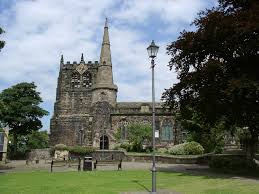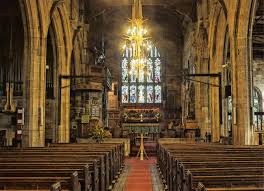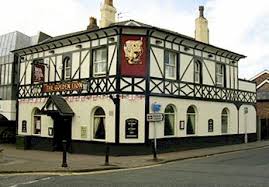Ormskirk is and has been since 1286, a market town. These days the market is held every Thursday, the traditional market day since the market charter was granted by King Edward I, and Saturday in the pedestrian town center.
We took a bus there terday to browse the market and the charity shops. The market was a bit cramped and disorganized due to major repairs being made to the pedestrian area of the town center around the clock tower. But suffice it to say that there was still plenty to browse and see.
Mike focused more on the market and scoping out a place for lunch while I did the charity shops. I did not find much on my formal list but I did find some reading material including a cookbook from the post WWII era that I began reading last night and find interesting. When the war ended in 1945 British rationing did not end. In fact, rationing in 1946-47 was quite severe due to multiple factors including bad weather. It was not until 1954 that rationing completely stopped. Nine years after the end of the war! WOW. That says a lot for the British stiff upper lip.
The church of St. Peter and St. Paul, the oldest building in Ormskirk, is unusual in that it has both a steeple and a church spire. It is one of only three English churches to boast both and is unique in the fact that both are at the same end of the church. The seventh Earl of Derby, a Royalist during the Civil War, is buried in the church in a rather unusual manner: his body is buried in one coffin and his head, separated from his body in 1651 by beheading, is buried in a separate casket.
Another interesting structure is Ormskirk's Clock tower, found in the center of the town, that was built in 1876, a late comer by European standards. :-)
We had limited time so could not fit in a visit to Chapel Gallery, a public art gallery, or to the beautiful gardens of Victoria Park and Coronation Park (commemorating the coronation of Victoria's son, Edward VII). Hopefully something for another day.





We took a bus there terday to browse the market and the charity shops. The market was a bit cramped and disorganized due to major repairs being made to the pedestrian area of the town center around the clock tower. But suffice it to say that there was still plenty to browse and see.
Mike focused more on the market and scoping out a place for lunch while I did the charity shops. I did not find much on my formal list but I did find some reading material including a cookbook from the post WWII era that I began reading last night and find interesting. When the war ended in 1945 British rationing did not end. In fact, rationing in 1946-47 was quite severe due to multiple factors including bad weather. It was not until 1954 that rationing completely stopped. Nine years after the end of the war! WOW. That says a lot for the British stiff upper lip.
The church of St. Peter and St. Paul, the oldest building in Ormskirk, is unusual in that it has both a steeple and a church spire. It is one of only three English churches to boast both and is unique in the fact that both are at the same end of the church. The seventh Earl of Derby, a Royalist during the Civil War, is buried in the church in a rather unusual manner: his body is buried in one coffin and his head, separated from his body in 1651 by beheading, is buried in a separate casket.
Another interesting structure is Ormskirk's Clock tower, found in the center of the town, that was built in 1876, a late comer by European standards. :-)
We had limited time so could not fit in a visit to Chapel Gallery, a public art gallery, or to the beautiful gardens of Victoria Park and Coronation Park (commemorating the coronation of Victoria's son, Edward VII). Hopefully something for another day.
No comments:
Post a Comment